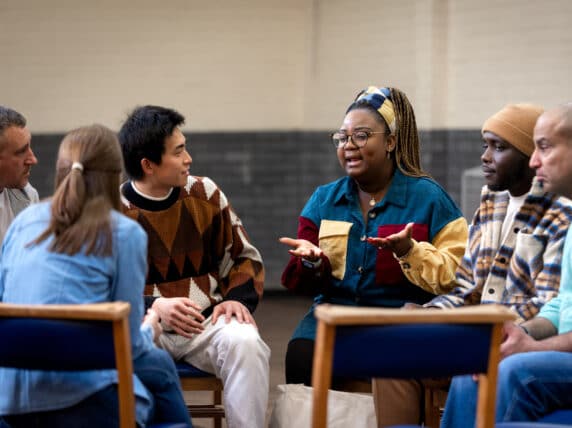The power of partnership and participatory video
Five years ago, the programme team at Opportunity International UK explored ideas on how to enhance our Monitoring, Evaluation, and Learning (MEL) processes.
In particular, we wanted to amplify the voices of the people we work with to influence programme design and improve outcomes, and support them to share their stories in their own words.
We were introduced to InsightShare and learned about their Participatory Video (PV) and Most Significant Change (MSC) approach to MEL and discussed how we could work together.
Embedding a participatory approach to MEL
Participatory Video is a set of techniques which brings a group together to explore local challenges and issues, voice concerns or simply be creative and tell stories. The process is empowering, enabling a community to communicate their needs and ideas to decision-makers and take action to find solutions to their problems. As such, Participatory Video can be a highly effective tool to engage and mobilise people, helping them to implement forms of sustainable development based on local needs.
The Most Significant Change technique is a form of participatory monitoring and evaluation, first developed in the 90s by Rick Davies. The process involves collecting stories from a community and systematically selecting the stories that represent the ‘most significant change’ among participants. When PV and MSC are skilfully brought together, the stories come to life on screen. PV techniques enable anyone to quickly learn the basics of using a video camera. This means people can record their own stories on camera in a familiar context and with their peers. The videos are then shared at community screenings to which local leaders, decision-makers and other stakeholders are invited.
As we learnt more about the process from InsightShare, we decided to incorporate participatory storytelling into the Opportunity International UK internal MEL strategy. The team wanted to be better equipped to listen and understand the lived experiences of the people participating in our financial inclusion programmes, and to improve our programming as a result.
In 2019, InsightShare trained the entire Opportunity International UK programme team, taking us through the process of story circles and journey mapping to identify the story with the Most Significant Change (MSC) and to capture this on film. Having learnt the methodology, InsightShare supported us to use the methods in evaluations of two financial inclusion programmes in Uganda, one with people living with disabilities and their caregivers, and another with refugees and host communities.
Join our Monitoring, Evaluation and Learning (MEL) working group!
The Bond MEL group focuses on sharing learning and experience among Bond members to help improve MEL practice across the sector. Whether MEL is in your job title, or it is part of your programmatic/advocacy work, this group is a place to share, learn and network on all things MEL.
Join the groupWhat have we learnt?
Five years later, we continue to use PV and MSC as a fundamental part of our MEL. It has been a wonderful organisational learning journey with a big impact.
Here are some key lessons that we learnt along the way:
- Envision the potential opportunity and make it happen: to keep the momentum going after the initial meetings and exploration, we kept an open channel for discussion to build the method in diverse proposals for future programmes. After two years, we hit the jackpot together.
- Bring everyone along with you: inviting the entire programmes team in Oxford to be trained in the methods before these were going to be rolled out was essential to strengthen capacities and get buy-in, but also to build momentum and encourage innovation across programmes.
- Embedding a new approach and method takes time: our timeline for embedding the methods in our programmes was three years, but with the Covid-19 pandemic, it got pushed to five years as both programmatic work and MEL were delayed.
- Put community members and local staff in the driving seat: in both programmes, those trained in Uganda were the affected populations alongside the local staff. These were people living with disabilities, carers, refugees, and local host community members working alongside local staff in evaluation teams. They facilitated the participatory MEL workshops themselves and undertook a participatory analysis of the results.
- Build in downward, upward and horizontal accountability: each participatory process created spaces for community participants to voice concerns and for local partners to address them, as well as to share results with other civil society and international actors working on the same issues through screenings and group discussions. Accountability to funders was also an important consideration but it was not the only focus.
- Trust your staff and build opportunities for continuity: the international and local staff trained are now able to replicate the approach, not only in these programmes but across other work in Uganda and other locations in Africa. Allowing staff to build confidence and share skills horizontally is crucial for innovation to be rooted into mainstream organisational systems.
If you are interested in the method and the results of our joint work, you can learn more about the methodology in the InsightShare toolkit and InsightShare’s Theory of Change video.
Category
News & ViewsThemes
MEL



